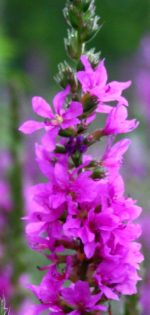 Purple loosestrife is a herbaceous perennial and member of the loosestrife family, Lythraceae, that also includes pomegranate and crepe myrtle, but is not related to other plants called loosestrife that are in the primrose family. It is native to wetlands of Europe and Asia and was introduced into northeastern US in the 1800s for ornamental and medicinal uses but now occurs in all of the 48 contiguous states except Florida, Louisiana, Georgia, South Carolina, and Arizona. Unfortunately, purple loosestrife has crowded out wetland species in some of the cooler areas of the US and is banned in several states. Growing two to ten feet tall, plants have an upright slightly hairy stem that is reddish purple and somewhat square in cross-section. The lanceolate, willow-like leaves occur in in twos or threes, clasp the stem, and are grayish green, slightly hairy, and one to four inches long. The 3/4″ wide, purplish pink flowers have five to seven petals and appear in sessile whorls on slender terminal spikes 6-12″ long throughout most of the summer giving way in the fall to capsules with many small seeds. Plants spread by underground stems and seed, and a singe plants can produce up to three million seeds in one year. The genus name, Lythrum, comes from the Greek word lythron meaning blood and refers to the color of the flowers. The specific epithet, salicaria, comes from the Latin word salix, meaning willow and refers to the appearance of the leaves.
Purple loosestrife is a herbaceous perennial and member of the loosestrife family, Lythraceae, that also includes pomegranate and crepe myrtle, but is not related to other plants called loosestrife that are in the primrose family. It is native to wetlands of Europe and Asia and was introduced into northeastern US in the 1800s for ornamental and medicinal uses but now occurs in all of the 48 contiguous states except Florida, Louisiana, Georgia, South Carolina, and Arizona. Unfortunately, purple loosestrife has crowded out wetland species in some of the cooler areas of the US and is banned in several states. Growing two to ten feet tall, plants have an upright slightly hairy stem that is reddish purple and somewhat square in cross-section. The lanceolate, willow-like leaves occur in in twos or threes, clasp the stem, and are grayish green, slightly hairy, and one to four inches long. The 3/4″ wide, purplish pink flowers have five to seven petals and appear in sessile whorls on slender terminal spikes 6-12″ long throughout most of the summer giving way in the fall to capsules with many small seeds. Plants spread by underground stems and seed, and a singe plants can produce up to three million seeds in one year. The genus name, Lythrum, comes from the Greek word lythron meaning blood and refers to the color of the flowers. The specific epithet, salicaria, comes from the Latin word salix, meaning willow and refers to the appearance of the leaves.
Type: Herbaceous perennial
Bloom: Purplish pink flowers with 5-7 petals, in slender spikes throughout most of the summer
Size: 3-5′ H x 2′ W
Light:Full sun but tolerate some shade.
Soil: Average, moist-wet, well-drained
Hardiness: Zones 3-9
Care: Low maintenance
Pests and Diseases: Japanese beetles
Propagation: Seed, division, stem cuttings
Companion Plants: Beebalm, queen of the prairie, mountain fleece
Outstanding Selections:
‘Firecandle’ (rose red flowers)
‘Robert’ (deep ink flowers)
‘Roseum Superbum’ (rosey-purpe flowers 1″ wide; very vigorous)
‘The Beacon’ (bright rose-red flowers; plants 3.5′ tall)